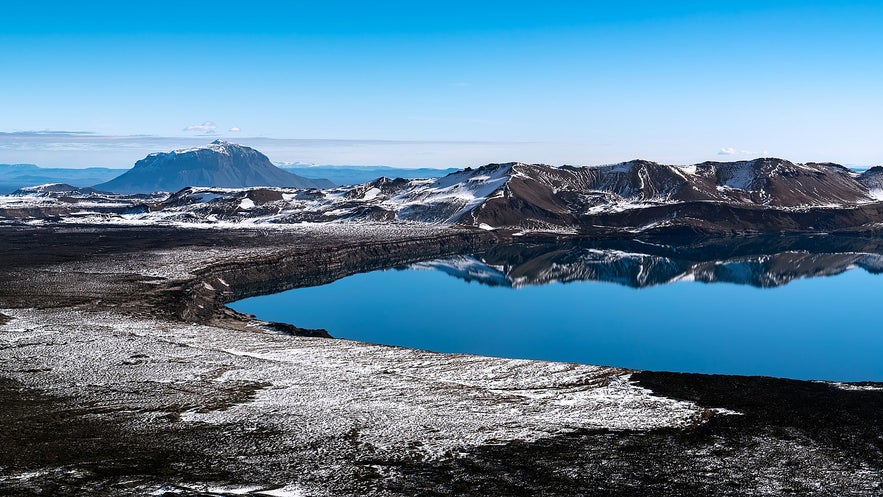
Askja es una caldera situada en las Tierras Altas centrales de Islandia, justo al norte del glaciar Vatnajökull. Es conocida por sus espectaculares erupciones y por haber servido de campo de entrenamiento a los astronautas del Apolo por alucinantes sus paisajes lunares.
Échale un vistazo a nuestra amplia selección de tours y excursiones por las Tierras Altas de Islandia.
Por Qué Puedes Confiar en Nuestro Contenido
Guide to Iceland es la plataforma de viajes más fiable de Islandia, que ayuda a millones de visitantes cada año. Todo nuestro contenido está escrito y revisado por expertos locales que conocen profundamente Islandia. Puedes confiar en nosotros para obtener consejos de viaje precisos, actualizados y fiables.
Foto superior de Wikimedia, Creative Commons, por Ilya Grigorik. Sin editar.
El punto más alto de las montañas que forman el cráter es de 1510 metros, una altura notable para un pico isleño.
Askja es un destino popular para los excursionistas, con refugios de montaña donde quedarse, aunque solo se puede acceder en verano con un vehículo todoterreno.
Grandes Erupciones en Askja
Askjano fue conocido durante la mayor parte de la historia de Islandia hasta 1875, cuando entró en erupción con gran fuerza y vertió cenizas tóxicas por gran parte de los Fiordos del Este. Las cenizas llegarían hasta Polonia, lo que nos da una idea de su magnitud.
El efecto sobre la población local fue catastrófico, ya que acabó tanto con el ganado como los cultivos. Esta situación forzó una gran oleada de emigración del país a Estados Unidos y Canadá. Así, muchas localidades en la costa este tienen una alta población de descendientes de islandeses, en particular la ciudad canadiense de Gimli.
Aunque parecía ser la primera vez de la erupción del Askja, no fue así. Hace 11000 años, la tefra de su erupción llegó hasta Rumanía.
El Askja entró en erupción por última vez en 1961, aunque en menor medida. No obstante, desde entonces se registra actividad sísmica, con temblores en la región en 2010 y sin capa de hielo en abril de 2012, lo que indica calor bajo el pico.
 Foto de Wikimedia, Creative Commons, por Ulrich Latzenhofer. Sin editar.
Foto de Wikimedia, Creative Commons, por Ulrich Latzenhofer. Sin editar.
Lago Öskjuvatn
Askja también es conocida por albergar el segundo lago más profundo de Islandia, Öskjuvatn, que pierde el primer puesto por la laguna glaciar Jökulsárlón, de reciente formación.
Situado a unos 50 metros por debajo del nivel principal del suelo de la caldera, posee una profundidad de hasta 220 metros.
Este lago se formó tras la erupción de 1875 y ocupa una superficie de doce kilómetros cuadrados. Está helado la mayor parte del año y, si se encuentra inusualmente líquido, es una señal preocupante de una posible erupción.
Ciencia y Askja
Askja se encuentra a la sombra del gran glaciar Vatnajökull. Esto significa que la zona es extraordinariamente seca, con solo 450 mm de lluvia al año, aproximadamente la mitad de lo que cae en Reikiavik. También es especialmente fría, debido a su elevación y proximidad al glaciar.
Estas condiciones hacen que la vegetación que rodea Askja sea escasa o nula, por lo que fue el lugar perfecto para que los astronautas del Apolo se aclimataran al entorno lunar. Aunque también se utilizaron otros lugares del país, como la Península de Reykjanes, se consideró que este entorno en particular era el reflejo más exacto de un paisaje lunar.
Los científicos del Apolo no fueron los únicos en visitar Askja, que atrajo a meteorólogos, geólogos y vulcanólogos durante décadas. De hecho, antes de que llegaran los astronautas, Askja ya se había cobrado la vida de dos personas que lo estudiaban.
En 1907, dos científicos alemanes, Walter von Knebel y Max Rudloff, estudiaban el volcán y salieron en barco a la superficie del Öskjuvatn. Nunca regresaron, ni se volvió a ver rastro de ellos, a pesar del duro trabajo de la prometida de von Knebel, Ina von Grumbkow.
Lo que les ocurrió ha sido un misterio eterno, cuya probable respuesta se encontró por fin en 2014.
Un estudio realizado ese año en la caldera reveló los efectos que puede tener un corrimiento de tierras en el lago. Cuando la tierra desplazada golpeó su superficie, provocó una ola de 30 metros de altura. Cualquier embarcación pequeña a su paso habría quedado completamente destrozada, y no es de extrañar que nunca se haya encontrado rastro de ellas.









